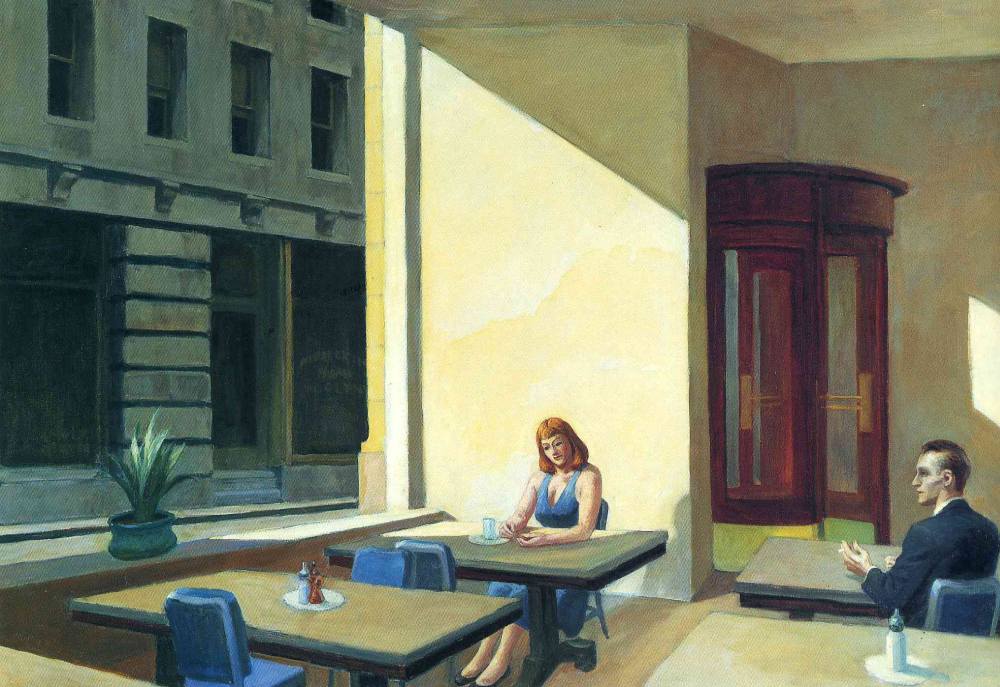
Meaning of “Sunlight in a Cafeteria” Painting by Edward Hopper
Edward Hopper, one of the most iconic American realist painters of the 20th century, is best known for his stark portrayals of urban isolation, psychological tension, and the intimate quietness of everyday life. Among his most evocative works is the 1958 painting “Sunlight in a Cafeteria.” This piece, though quieter and perhaps less discussed than his masterwork Nighthawks, remains a haunting, meditative exploration of human isolation, longing, and fleeting moments of connection , all bathed in the harsh clarity of sunlight. The painting is not merely a scene frozen in time; it is a layered visual poem that encapsulates the emotional terrain of modern American existence.
What Is “Sunlight in a Cafeteria” About?
At first glance, “Sunlight in a Cafeteria” appears deceptively simple: a man and a woman sit at opposite ends of a long table in a near-empty cafeteria, bathed in intense sunlight filtering through large windows. The woman looks out of the window, her body turned away from the man, who sits with hands folded, looking down. The vast space around them emphasizes the emotional chasm between the two figures.
But this painting is not simply about a mundane moment , it is about what that moment says about the broader human condition. It captures a mood of psychological stillness and social alienation. Hopper distills a common American scene into a tableau of emotional ambiguity, where presence does not equal connection, and light does not bring clarity.
Who Painted It and How: Edward Hopper’s Technique and Process
Edward Hopper (1882–1967) was an American realist painter whose style was influenced by Impressionism, photography, and American Scene Painting. He created “Sunlight in a Cafeteria” in 1958, during the final decade of his artistic career. Like most of his major works, Hopper painted it in his studio in New York City, after producing a series of preliminary sketches and studies from life. His process was meticulous: he first visualized the composition in pencil, studying light angles and geometry, and then brought it to life on canvas using oil paint.
Hopper’s wife, Josephine (Jo) Nivison Hopper, who was also a painter, served as the model for the woman in the painting. She was Hopper’s muse and most frequent model. Their relationship , intimate yet often emotionally strained , resonates through many of his canvases, especially in those involving couples.
The painting reflects Hopper’s characteristic precision of architectural form, careful use of linear perspective, and almost photographic light, but it remains far more than a realist depiction. His art transcends representation by imbuing the ordinary with existential weight.
What Is Happening in the Painting?
The most apparent action in “Sunlight in a Cafeteria” is that nothing much is happening , and that is the point. Hopper captures the in-between moments of life: when the world is in motion, yet time seems to pause for the individuals within it.
The man and woman are both absorbed in their thoughts. They are physically close but emotionally distant. The woman stares out the window, perhaps lost in reflection or longing for something outside the scene. The man looks downward, possibly contemplating something internal or avoiding interaction. The harsh sunlight casts long shadows, heightening the mood of separation.
There is no narrative in the traditional sense , no event, no climax , yet the painting speaks volumes about human disconnection and quiet introspection. This silence is powerful and unsettling, revealing the loneliness that can exist in public spaces.
What Does the Sunlight in a Cafeteria Painting Represent?
Hopper was not a symbolist in the classical sense, but his images are laden with metaphor and psychological depth. In “Sunlight in a Cafeteria,” nearly every element contributes symbolically to its deeper meaning:
1. The Sunlight
The harsh, angular sunlight pouring into the cafeteria is both literal and symbolic. Traditionally, sunlight suggests warmth, clarity, or optimism. But Hopper subverts this expectation. Here, the light is blinding, stark, even oppressive. It enhances the isolation of the figures rather than alleviating it. The sunlight forces clarity but not comfort. It may reflect an unwanted exposure , of emotions, truths, or absences.
2. The Cafeteria Setting
The cafeteria is a transitory, impersonal space, not one of home or intimacy. It is a space where people eat alone or in silence, especially in urban settings. This location emphasizes urban alienation, a recurring theme in Hopper’s work. The cafeteria becomes a metaphor for modern life , places filled with people yet empty of connection.
3. The Long Table
The table stretches across the composition, symbolizing emotional distance. Although the two figures are sitting at the same table, the space between them is vast. This spatial metaphor highlights the invisible wall that can exist even between people in close proximity , perhaps lovers, strangers, or former companions.
4. The Window
The window often appears in Hopper’s paintings as a symbol of longing or escape. In this scene, the woman’s gaze through the window might represent her yearning for a different reality, or her emotional detachment from the man beside her. The window is transparent but unreachable , a paradox that mirrors human relationships.
What Type of Art Is “Sunlight in a Cafeteria”?
“Sunlight in a Cafeteria” belongs to the American Realist tradition, more specifically to American Scene Painting and Modern Realism. Hopper’s work is realistic in that it depicts recognizable urban environments and human figures with natural proportions and lighting. However, he infuses realism with a cinematic and psychological intensity that transcends mere representation.
The influence of photography and cinema is unmistakable in Hopper’s framing, use of light, and mise-en-scène. His scenes are often described as “film stills” because they feel like moments captured just before or after something significant.
Although Hopper rejected the more overt emotionalism of Expressionism and the abstraction of Modernist movements like Cubism or Abstract Expressionism, his work is deeply modern in its existential concerns and minimalist aesthetic.
What Is the Deeper Meaning?
At its core, “Sunlight in a Cafeteria” is a meditation on solitude, alienation, and the unspoken tensions of human interaction. It belongs to a broader cultural critique of post-war American life. By the 1950s, American society was undergoing rapid urbanization and modernization. Suburbs grew, but cities remained centers of industry, anonymity, and loneliness.
The painting reflects the disconnect in human relationships in an increasingly mechanized and impersonal world. It suggests that being with someone does not necessarily alleviate isolation , in fact, shared silence can feel lonelier than being alone.
Psychologically, the painting also touches on themes of emotional repression, routine, and the void beneath surface appearances. The sunlight reveals everything, but does it offer understanding or merely exposure?
Where Is the “Sunlight in a Cafeteria” Painting Now?
As of today, “Sunlight in a Cafeteria” resides in the collection of the Yale University Art Gallery in New Haven, Connecticut. It was gifted to the institution and has become one of the notable works in their American painting collection.
Yale’s acquisition of this piece ensures that it is preserved not only as an aesthetic masterpiece but also as a critical artifact of American cultural and psychological history.
How Does It Relate to Other Hopper Works?
“Sunlight in a Cafeteria” shares thematic DNA with several other Hopper paintings, such as:
“Nighthawks” (1942): Both depict public spaces (a diner and a cafeteria) and people who are physically near but emotionally isolated.
“Automat” (1927): Features a solitary woman sitting with coffee, much like the female figure here, immersed in introspection.
“Office at Night” (1940): Captures another ambiguous male-female relationship in a brightly lit yet emotionally dim setting.
What differentiates “Sunlight in a Cafeteria” is its austerity and detachment. The figures seem less involved with each other than in Hopper’s other works. Here, the emphasis is almost entirely on emotional stillness and the passage of unremarkable time, which paradoxically becomes remarkable through Hopper’s lens.
Why “Sunlight in a Cafeteria” Still Resonates
Edward Hopper’s genius lies not in his technical skill alone , though he was a master of light, space, and composition , but in his ability to convey the emotional architecture of modern life. In “Sunlight in a Cafeteria,” he achieves this with quiet elegance.
The painting is a mirror: it reflects the loneliness that lies beneath the surface of urban life, the silence within conversations, and the spaces between people. It makes us look not just at the figures in the cafeteria but also at ourselves , our habits, our longing for connection, and our silent moments of introspection.
In an age of digital connection and physical disconnection, Hopper’s vision remains acutely relevant. “Sunlight in a Cafeteria” is more than a painting , it is a poignant, visual novel of a moment many have lived but few have noticed.
Sources:
Yale University Art Gallery archives
“Edward Hopper: An Intimate Biography” by Gail Levin
Art Institute of Chicago and Whitney Museum publications
Hopper’s personal journals and sketchbooks image/artchive.com




